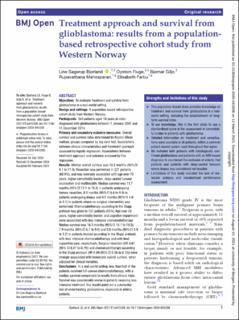| dc.contributor.author | Bjorland, Line Sagerup | |
| dc.contributor.author | Fluge, Oystein | |
| dc.contributor.author | Gilje, Bjornar | |
| dc.contributor.author | Mahesparan, Rupavathana | |
| dc.contributor.author | Farbu, Elisabeth | |
| dc.date.accessioned | 2021-08-18T08:14:25Z | |
| dc.date.available | 2021-08-18T08:14:25Z | |
| dc.date.created | 2021-07-06T15:39:32Z | |
| dc.date.issued | 2021 | |
| dc.identifier.issn | 2044-6055 | |
| dc.identifier.uri | https://hdl.handle.net/11250/2770004 | |
| dc.description.abstract | Objectives
To evaluate treatment and survival from glioblastoma in a real-world setting.
Design and settings
A population-based retrospective cohort study from Western Norway.
Participants
363 patients aged 18 years or older diagnosed with glioblastoma between 1 January 2007 and 31 December 2014.
Primary and secondary outcome measures
Overall survival and survival rates determined by Kaplan-Meier method, groups compared by log-rank test. Associations between clinical characteristics and treatment approach assessed by logistic regression. Associations between treatment approach and outcome analysed by Cox regression.
Results
Median overall survival was 10.2 months (95% CI 9.1 to 11.3). Resection was performed in 221 patients (60.9%), and was inversely associated with age over 70 years, higher comorbidity burden, deep-seated tumour localisation and multifocality. Median survival was 13.7 months (95% CI 12.1 to 15.4) in patients undergoing tumour resection, 8.3 months (95% CI 6.6 to 9.9) in patients undergoing biopsy and 4.5 months (95% CI 4.0 to 5.1) in patients where no surgical intervention was performed. Chemoradiotherapy according to the Stupp protocol was given to 157 patients (43%). Age over 70 years, higher comorbidity burden and cognitive impairment were associated with less intensive chemoradiotherapy. Median survival was 16.3 months (95% CI 14.1 to 18.5), 7.9 months (95% CI 6.7 to 9.0) and 2.0 months (95% CI 0.9 to 3.2) in patients treated according to the Stupp protocol, with less intensive chemoradiotherapy and with best supportive care, respectively. Surgical resection (HR 0.61 (95% CI 0.47 to 0.79)) and chemoradiotherapy according to the Stupp protocol (HR 0.09 (95% CI 0.06 to 0.15)) were strongly associated with favourable overall survival, when adjusted for clinical variables.
Conclusions
In a real-world setting, less than half of the patients received full-course chemoradiotherapy, with a median survival comparable to results from clinical trials. Survival was considerably worse in patients receiving less intensive treatment. Our results point out a substantial risk of undertreating glioblastoma, especially in elderly patients. | en_US |
| dc.language.iso | eng | en_US |
| dc.publisher | BMJ Publishing Group | en_US |
| dc.rights | Navngivelse-Ikkekommersiell 4.0 Internasjonal | * |
| dc.rights.uri | http://creativecommons.org/licenses/by-nc/4.0/deed.no | * |
| dc.title | Treatment approach and survival from glioblastoma: results from a population-based retrospective cohort study from Western Norway | en_US |
| dc.type | Journal article | en_US |
| dc.type | Peer reviewed | en_US |
| dc.description.version | publishedVersion | en_US |
| dc.rights.holder | Copyright Author(s) (or their employer(s)) 2021. | en_US |
| dc.source.articlenumber | e043208 | en_US |
| cristin.ispublished | true | |
| cristin.fulltext | original | |
| cristin.qualitycode | 1 | |
| dc.identifier.doi | 10.1136/bmjopen-2020-043208 | |
| dc.identifier.cristin | 1920526 | |
| dc.source.journal | BMJ Open | en_US |
| dc.identifier.citation | BMJ Open. 2021, 11 (3), e043208. | en_US |
| dc.source.volume | 11 | en_US |
| dc.source.issue | 3 | en_US |

